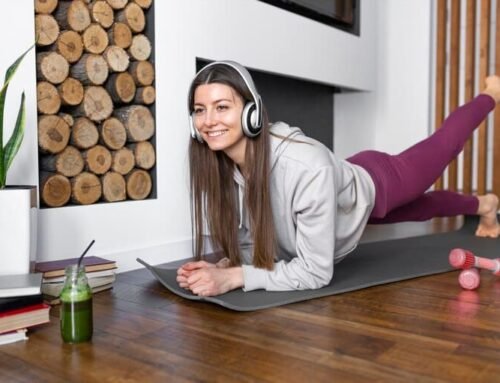Our breath is key to our health, yet we often ignore it. Breathing is automatic, but it affects our mind and body deeply. This article will show how deep breathing can improve focus, peace, and lung health.
Breathing links closely to our feelings and thoughts. By controlling our breath, we can enjoy many benefits. These include less stress and anxiety, better focus, and stronger lungs. Deep breathing is great for managing stress, boosting brain power, or just feeling better overall.
Key Takeaways :Deep Breathing Techniques
- Breathing exercises can have a significant impact on mental and physical health.
- Deep breathing can reduce stress and anxiety, improve focus and mental clarity.
- Proper breathing techniques can enhance lung capacity and respiratory health.
- Incorporating breathing exercises into your daily routine can lead to long-term benefits.
- Combining deep breathing with other relaxation techniques can further amplify the positive effects.
The Power of Controlled Breathing
Breathing exercises are great for both our bodies and minds. By controlling our breath, we can enjoy many benefits that make us healthier and happier. These benefits include less stress, less anxiety, better focus, and clearer thinking.
Understanding the Benefits of Breathing Exercises
Practicing breathing techniques can turn on the “rest and digest” system in our bodies. This system helps fight stress, lowers blood pressure, and makes our heart rate more stable. It also helps us feel calm and relaxed.
Controlled breathing can make us think better too. It helps us focus, concentrate, and think more clearly.
Reduced Stress and Anxiety
Breathing exercises are great for easing stress and anxiety. By breathing slowly and taking longer breaths out, we can relax. This is especially good for people who deal with anxiety or have a lot of stress.
Improved Focus and Mental Clarity
Controlled breathing also helps us think better. The steady rhythm of our breath can calm our minds and make us more aware. This leads to better focus, clearer thinking, and can make us more productive and decisive.
“Breathing is the foundation of all meditation practices and is the root of all life.” – Dr. Andrew Weil
Essential Deep Breathing Techniques

Learning deep breathing can greatly improve your health and well-being. Let’s look at some top deep breathing techniques. These can help you focus better, find peace, and improve your lung health.
Diaphragmatic Breathing
Diaphragmatic breathing, or belly breathing, is a key technique. It strengthens the diaphragm and helps you relax. By breathing into your belly, you boost oxygen levels and calm your mind.
4-7-8 Breathing Technique
Dr. Andrew Weil created the 4-7-8 breathing technique. It’s easy but powerful, helping to reduce stress and relax you. You breathe in for 4 seconds, hold for 7, and breathe out for 8. This pattern balances your nervous system and brings deep calm.
Box Breathing
Box breathing, or square breathing, is great for relaxation and focus. You breathe in for 4 seconds, hold for 4, breathe out for 4, and hold again for 4. This creates a square pattern. It’s very helpful for those feeling stressed or anxious.
Adding these deep breathing techniques to your daily life can unlock your lungs’ power. You’ll gain focus, peace, and better overall health.
Deep Breathing Techniques

Using deep breathing techniques can greatly improve your mental and physical health. These include diaphragmatic breathing, the 4-7-8 method, box breathing, and alternate nostril breathing. They help lower stress, improve focus, manage emotions, and boost cardiovascular and respiratory health.
Diaphragmatic Breathing
Known as belly breathing, this method involves slow, deep breaths that make the belly expand, not the chest. It oxygenates the blood, relaxes muscles, and helps you feel calm.
The 4-7-8 Technique
This technique means breathing in for 4 seconds, holding for 7, and breathing out for 8. It’s a way to calm your mind and find peace.
Box Breathing
Box breathing, or square breathing, means breathing in for 4 seconds, holding for 4, breathing out for 4, and holding again for 4. This pattern helps reduce anxiety and improve focus.
| Breathing Technique | Benefits |
|---|---|
| Diaphragmatic Breathing | Oxygenates the blood, reduces muscle tension, induces relaxation |
| 4-7-8 Technique | Calms the mind, promotes inner peace |
| Box Breathing | Reduces anxiety, enhances focus |
Adding these deep breathing techniques to your daily life can change your lung health, emotional state, and overall life quality.
Breathing for Stress Reduction

Stress is a normal part of life, but it’s important to know how to handle it. Our breathing plays a big role in managing stress and finding calm. This is backed by science.
The Science Behind Stress and Relaxation
When we face stress, our brain releases hormones like adrenaline and cortisol. These hormones help us focus and react. This process is controlled by the sympathetic nervous system.
On the other hand, when we’re relaxed, the parasympathetic nervous system kicks in. It helps us relax and save energy.
How Breathing Affects Your Nervous System
Deep, slow breathing activates the parasympathetic nervous system. This system affects our heart rate, making it slower. This slower heart rate brings us a sense of calm and relaxation.
Studies show that breathing exercises are great for stress reduction. They help lower cortisol, the main stress hormone.
“Breathing is a powerful tool for managing stress and promoting overall well-being. By understanding the connection between our breath and nervous system, we can unlock a deeper sense of focus and peace.”
Integrating Breathwork into Daily Life

To fully benefit from breathing exercises, make them a part of your daily life. A regular breathwork practice can bring many benefits. It can become a key part of your lifestyle.
Create a Breathwork Routine
Set aside a specific time each day for breathing exercises. This helps make it a habit and ensures you get the most out of it. Choose a time like morning, lunch, or before bed. Having a dedicated time for breathwork can really help.
Utilize Breathwork Apps
Smartphone apps for breathing exercises are great tools. They guide your practice and help you stay on track. These apps offer step-by-step instructions, timers, and personalized programs for your needs.
Combine Breathwork with Other Relaxation Techniques
Adding breathing exercises to other relaxation methods like meditation or yoga can boost their effects. This mix of techniques can lead to a deeper sense of well-being.
| Breathwork Routine | Breathwork Apps | Combining Breathwork |
|---|---|---|
|
|
|
“Incorporating breathwork into your daily life is a powerful way to cultivate focus, peace, and overall well-being. By making it a habit, you’ll unlock the transformative potential of this simple yet profound practice.”
Remember, the key to successfully integrating breathwork into your life is to approach it with consistency and creativity. Try different techniques to see what works best for you. Make it a special part of your self-care routine.
Also Read : Best Tips For Maintaining A Healthy Lifestyle
Conclusion
Deep breathing exercises have clear benefits. By learning techniques like diaphragmatic breathing and the 4-7-8 method, you can improve lung health, boost focus and mental clarity, and lower stress and anxiety. Adding these to your daily life, using tech to help, and mixing them with other relaxation methods can bring you peace of mind and better health.
Breathing exercises are easy yet powerful. They can change how you feel physically and mentally. If you want to get better at breathing, think clearer, or handle stress, the methods in this article can help. Start using deep breathing to get more focus, clarity, and calm in your life.
The path to better lungs and a calm mind begins with breathing. Stick with a regular breathwork routine, and you’ll see the big benefits of controlled, mindful breathing. Use these key deep breathing techniques to start a journey of more energy, focus, and peace inside.
FAQs
Q: What are deep breathing exercises and how can they help with lung health?
A: Deep breathing exercises involve intentional inhalation and exhalation techniques that can help improve lung function, relieve stress, and promote overall peace and calm. By focusing on your breath, you can increase oxygen intake and strengthen your diaphragm, leading to better lung health.
Q: How can I practice breath focus during my breathing sessions?
A: To practice breath focus, find a comfortable position, either sitting in a chair or lying down. Close your eyes and concentrate on your inhalations and exhalations. You may use a word or phrase to help you stay focused, such as “peace” while you breathe in and “calm” while you breathe out. This can help you feel more relaxed and centered.
Q: What is belly breathing and how does it differ from shallow breathing?
Belly breathing
A: Belly breathing, also known as diaphragmatic breathing, involves using your diaphragm to draw air deep into your lungs. This technique helps expand your stomach as you inhale, which is different from shallow breathing that primarily uses the chest. Belly breathing can relieve tension and improve oxygen flow, making you feel more relaxed.
Q: Can you explain the alternate nostril breathing technique?
A: Alternate nostril breathing is a yogic breathing technique where you close one nostril with your finger and inhale through the other, then switch sides. This method helps balance the left and right hemispheres of the brain and may help relieve stress levels, promoting a sense of peace and calm.
Q: What role does exhaling play in deep breathing techniques?
A: Exhaling is just as important as inhaling in deep breathing techniques. When you exhale fully, you release carbon dioxide and toxins from your body, which can help relieve tension and stress. Focus on a long, slow exhale to enhance relaxation and soothe your mind.
Q: How can I incorporate breathing practices into my daily routine?
A: You can incorporate breathing practices into your daily routine by setting aside a few minutes each day for deep breathing exercises. You can practice them while sitting in a chair, lying down, or even standing. Aim to practice in the morning or before bed to help you fall asleep more easily and relieve stress from the day.
Q: Are there specific breathing techniques for stress relief?
A: Yes, several breathing techniques can help relieve stress. Some popular methods include belly breathing, deep diaphragmatic breathing, and alternate nostril breathing. These practices focus on breath control and can help lower stress levels, release tension in your muscles, and promote relaxation.
Q: How can practicing deep breathing help if I’m feeling tense or anxious?
A: Practicing deep breathing can significantly help reduce feelings of tension or anxiety. By focusing on your breath, you activate your body’s relaxation response, which helps calm your mind and ease muscle tension. This can lead to a greater sense of peace and calm, allowing you to manage stress more effectively.
Q: Is it necessary to use specific words or phrases during deep breathing exercises?
A: While it’s not necessary to use specific words or phrases, doing so can enhance your focus and intention during deep breathing exercises. Using a word or phrase such as “relax” or “let go” can help reinforce your commitment to breathing deeply and may improve your overall experience during the session.
Source Links
- https://www.joincurio.com/post/the-power-of-breath-harnessing-breathing-exercises-for-improved-mental-and-physical-well-being
- https://kirbanu.com/breathwork/
- https://perfectpaddles.com/how-to-improve-your-breathing-for-on-and-off-the-water-perfect-paddles/








Leave A Comment